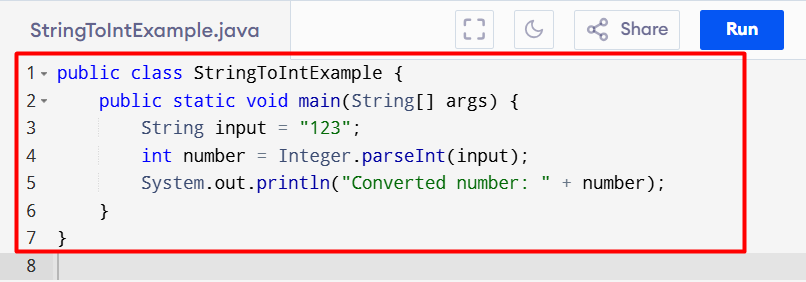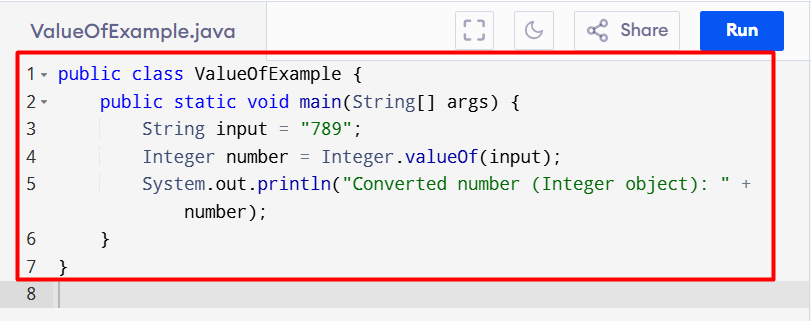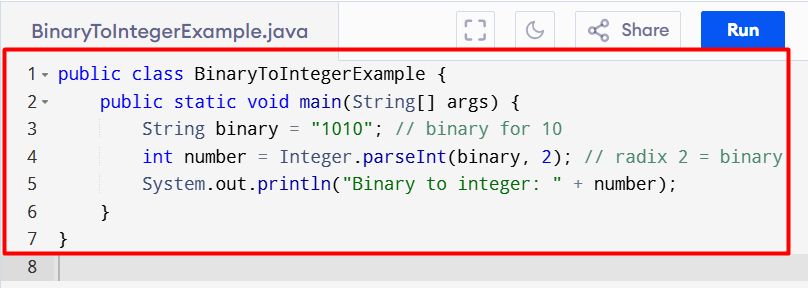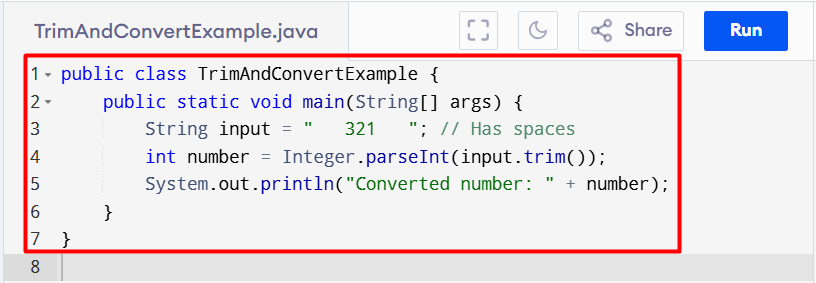Understanding Java List Usage with Examples
A List in Java is an interface in the java.util package...

Java usually thinks of user input or data as a string, even if that data is representative of a number. Therefore, you need to convert those strings into integers to perform arithmetic operations, comparisons, and perform more reliable and error-free programming.
One common example, you may retrieve numbers from forms, configuration files, and API results. These inputs are presented as text or a string type, but you still need to utilize those numbers in calculations or logic. If you do not convert those strings to integers then the program may throw an exception or return the incorrect output.
In this article, you will learn simple ways and reliable ways to convert a string to int Java.
Java treats a string and an int as two separate data types and has different uses for both. A string is a way to store characters, while an int stores numeric values to be utilized in mathematics and comparisons. You cannot do anything with strings and ints directly.
In the real world many inputs are in the string format. In the case of configuration settings many will store a numeric value in string format. In web forms and graphical user interfaces, numbers will be collected as strings and an API will return JSON data, where the numbers are returned as string values.
In order to utilize these inputs in the context of conditions, loops, or calculations they must be parsed. Java string to integer parsing is part of the data conversion process in Java and serves to ensure the program works with user input correctly and efficiently.
Java provides multiple ways to convert a string to an integer. Each method serves a different purpose and is well suited to different situations depending on whether a primitive int or the Integer Object is required. Part of parsing for a primitive type in Java also involves dealing with invalid inputs so the program does not crash.
Unlock the power of Ulta Web Hosting
Ultahost offers budget-friendly web hosting plans with features like unlimited bandwidth, SSL certificates, and easy content management systems installation.
The Integer.parseInt() method is the most straightforward way to parse a string into a primitive int. It is a method of the Integer class in the java.lang package. The parseInt() method returns an integer value from parsing the string, if the input string contains valid digits only.
The syntax is simple:
public class StringToIntExample {
public static void main(String[] args) {
String input = "123";
int number = Integer.parseInt(input);
System.out.println("Converted number: " + number);
}
}

The following example code assigns the integer value 123 to the variable number. The input string must contain a valid number and cannot contain any non-numeric characters or whitespace. If not, the parseInt() method produces a NumberFormatException.

Use this method when you only need a plain int and do not need the overhead of creating an Object. This method presents to be the most useful for calculations and loops and other general purposes when a primitive is useful enough.
The Integer.parseInt demo is one type of parsing numeric strings in Java programs and probably the most common.You may need tp know about query string from your Javascript files, learn also How to Remove Query Strings from Static Resources in WordPress.
Another option to convert a string to an int is Integer.valueOf(). This method also parses a string, just like parseInt(), but instead of returning a primitive int, it returns an Integer object.
Here’s how it works:
public class ValueOfExample {
public static void main(String[] args) {
String input = "789";
Integer number = Integer.valueOf(input);
System.out.println("Converted number (Integer object): " + number);
}
}

This line converts the string “123” to an “Integer” object. Still the content of the string must be a valid numeric value, the same as parseInt():

The difference is the return type. Integer.valueOf() returns an object, which is much more useful when working with collections such as ArrayList or if you need to consider null. Since Integer is an object, it wraps the int and provides object methods that offer more flexibility when using the type.
This mechanism offers the flexibility of Java type conversion to make connections between the string data and the object-oriented use case.
Both parseInt() and valueOf() cause a NumberFormatException if the string cannot be converted. The NumberFormatException occurs if the string includes letters, special characters, and any time the string is empty or null.
Surround the conversion in a try-catch block to avoid crashing the program. This is a good way to handle errors in Java and helps to work around errors that may result in an unsuccessful program run.
Here is a basic example:
public class ExceptionHandlingExample {
public static void main(String[] args) {
String input = "abc"; // Invalid number
try {
int number = Integer.parseInt(input);
System.out.println("Converted number: " + number);
} catch (NumberFormatException e) {
System.out.println("Error: Invalid number format.");
}
}
}

In this case, “abc” is not a legal number, so our catch block has printed out an error message (along with the exception) instead of terminating the program.

Input should always be validated or cleaned before conversion. If you do clean or validated the string using trim or using regex, you can reduce the chances of an invalid conversion. Input Validation is an important form of safe programming in Java so that your code is working like it should with real data.
Using the right method, with exception handling, allows Java programmers to easily and safely convert string values to usable integer values, ensuring they work in the correct context. Read more about use of Java script, How to Use JavaScript to Get the Current Date and Time.
The fundamental difference between Integer.parseInt() and Integer.valueOf() is whether you’re receiving a primitive or complex return type, and then recognizing the differences of when to choose one or the other method.Integer.parseInt() returns a primitive int type. It is the best option when you want to perform math or comparisons on the numeric value directly. Since primitive types are more performant because they consume less memory, parseInt is your first choice, if you are working on a performance driven application.
Alternatively, Integer.valueOf() produces an Integer object. This is helpful if you may not always strictly need the return value; for example, if you might eventually store the result in collections like ArrayList, or because you might have to deal with a null value (Integer variables can be null). By using the wrapper class Integer, you can also use object methods if you are implementing a more complex program.
Java int vs Integer: converting between the two depends on whether you need the performance of a primitive type, or the flexibility of an object type with many more features.
You can use the Integer.parseInt() method in convert string to int java representing a number in a base or a radix (for example, binary, octal, decimal, and hexadecimal) to an integer. The second parameter of the parseInt() method specifies the radix.
For example, to convert a binary string “1010” to an integer, use:
public class BinaryToIntegerExample {
public static void main(String[] args) {
String binary = "1010"; // binary for 10
int number = Integer.parseInt(binary, 2); // radix 2 = binary
System.out.println("Binary to integer: " + number);
}
}

In the following line of code, for example, 2 represents the binary numbering or counting system. You may find the capability to parse hexadecimal strings, using a radix of 16, useful; for working with things in the binary format or examples of hexadecimal use cases often found in low-level programming, dealing with specific network protocols, or when working with a memory address.
To know more How to Combine External Javascript and CSS in WordPress.
A frustrating situation when parsing strings, is to have blundered into unforeseen spaces before or after the actual number. If a user or file provides input with unforeseen spaces, it can ultimately lead to errors when converting to the number. Therefore, it’s valuable to sanitize or clean the input prior to converting it!
We can use the .trim() method to handle leading or trailing whitespace in the string:
public class TrimAndConvertExample {
public static void main(String[] args) {
String input = " 321 "; // Has spaces
int number = Integer.parseInt(input.trim());
System.out.println("Converted number: " + number);
}
}

By trimming the whitespace from the input string, you can ensure any whitespace left behind will not interfere with the conversion. Simply by trimming string input we can avoid a few mistakes and make sure the input is sanitized in Java:

In java convert string to int is the best way to capture numeric input, particularly for users providing more data through forms, configuration objects or APIs. Using Integer.parseInt() and Integer.valueOf() methods, make it convenient for developers to convert strings to integers to then be able to perform calculations, comparisons and other activities without the errors we try to avoid. It’s also important to handle invalid inputs which you can do by wrapping attempts to convert the string into number in try-catch blocks to avoid crashing the program and somewhat improve overall user experience.
Recognizing when you need to use either a primitive int or an Integer object based on the requirements of your program are crucial parts to creating efficient and flexible code. Java has many tools for making safe string to integer conversions, whether that be using collections, validating input, or converting numbers from different formats. As long as a developer feels confident in applying these methods, they can avoid potential pitfalls and create reliable and fail-safe applications.
While manually Converting String to Integer in Java can improve website performance it can be a time-consuming task. Ultahost’s shared hosting plans offer a user-friendly solution. Many plans come pre-configured with caching plugins that can automatically combine and minify your website’s Javascript and CSS files.
Integer.parseInt() returns a primitive int, while Integer.valueOf() returns an Integer object. Use parseInt() for primitive values and valueOf() when working with objects or collections.
No, Integer.parseInt() throws a NumberFormatException if the string contains non-numeric characters. Ensure the string contains only digits or handle exceptions.
An empty string will throw a NumberFormatException. Validate the input or check for an empty string before conversion.
Radix refers to the base of the number system (e.g., 2 for binary, 16 for hexadecimal). The second argument in Integer.parseInt() allows specifying the radix for different number systems.
Use the trim() method to remove leading and trailing spaces from the string before converting. This ensures the string is clean for accurate conversion.
Yes, Integer.valueOf() can be slightly slower because it returns an Integer object, which requires additional object creation. Use parseInt() for better performance with primitive int values.
If the input string is null, both Integer.parseInt() and Integer.valueOf() will throw a NullPointerException. Always ensure the string is not null before attempting to convert.